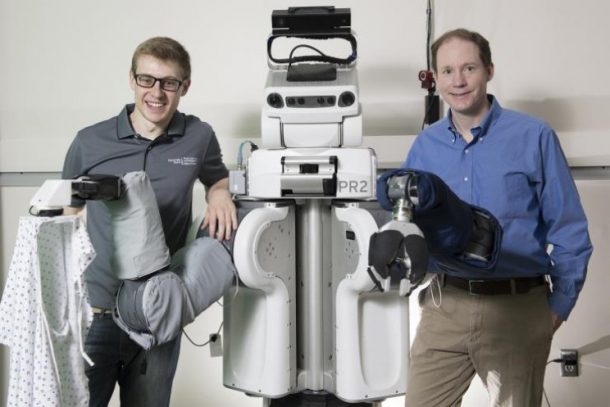Georgia Tech has developed a robot which will be used to dress patients in the hospital gowns and elderly homes. The University gave a statement saying, “More than 1 million Americans require daily physical assistance to get dressed because of injury, disease and advanced age.” The researchers are developing a robot which can successfully slide the hospital gown on people’s arms. The machine makes use of its understanding of force to guide the cloth on the person’s hands, arms and on the shoulder.

The robot is named as PR2 and it taught itself to complete the task in a single day. It analyzed over 11,000 simulated examples of a robot putting a gown onto the human arm and learned the method. By analyzing this data, the PR2’s neural network learned to estimate the forces which are applied to the human. The simulations allowed the robot to feel how it is to get a human dressed. Zackory Erickson, the lead Georgia Tech Ph.D student said, “People learn new skills using trial and error. We gave the PR2 the same opportunity. Doing thousands of trials on a human would have been dangerous, let alone impossibly tedious. But in just one day, using simulations, the robot learned what a person may physically feel while getting dressed.”
The examples allowed the robot to make predictions of the consequences of different motions. In some cases, moving the gown down was making the cloth being pulled tight and other times it was slid smoothly. These motions allowed the robot to use the right motions to dress the patient. When the robot was considered efficient with the simulations, it switched to patients and tried to slide the gown onto their arm. The robot cannot see but it uses its sense of touch to know what it is doing. Charlie Kemp, an associate professor in the Wallace H. Coulter Department of Biomedical Engineering at Georgia Tech and Emory University and the lead faculty member, said, “The key is that the robot is always thinking ahead. It asks itself, ‘if I pull the gown this way, will it cause more or less force on the person’s arm? What would happen if I go that way instead?”
During the human testing, the timings of the robot were adjusted so that its chances of being successful could also be increased. Kemp said, “The more robots can understand about us, the more they’ll be able to help us. By predicting the physical implications of their actions, robots can provide assistance that is safer, more comfortable and more effective.” Till now, the robot is only able to just slide the sleeve of the gown on the arm of a patient. According to the researchers, the main goal is to enable the machine to fully dress a patient.
Let’s wait and see how efficient this robot can be at this task.


